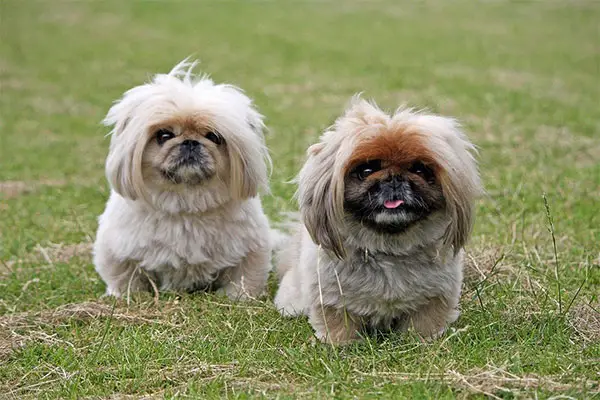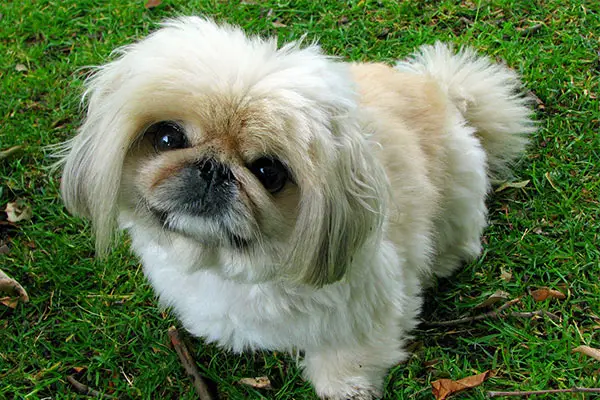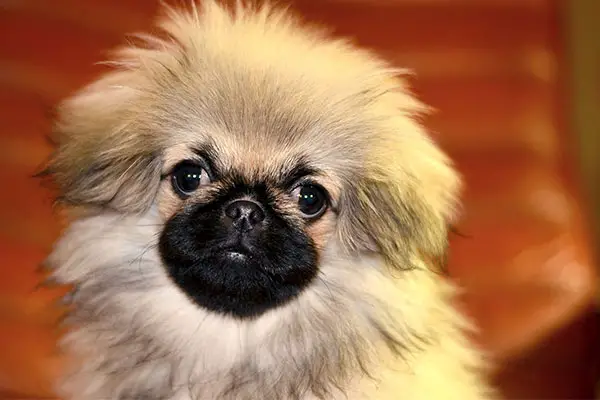Pekingese dogs or Pekes are toy dogs that only stand at a height of 6-9 inches. Their small, compact bodies are covered with a long coat (longest at the neck and shoulders), which comes in various colors. They have short muzzles, a v-shaped nose, ears that hang, and large eyes.
These dogs make excellent companion dogs for travel because of their small size. They are known to be charming and confident, as well. Though it’s tempting to get them as dogs for your kids, Pekes are not the best dog breed for small children.
Pekingese dogs may require a lot of work to raise, and they need someone who can give them lots of love and affection. If that happens to be you, then you’re in luck because they’ll surely brighten up your day.
Pekingese Breed Statistics
| Dog Breed Group | Toy |
| Breed Size | Small |
| Height | 6-9 inches |
| Weight | Up to 14 pounds |
| Lifespan | 12-14 years |
Pekingese Breed Ratings
| Energy level | |
| Exercise needs | |
| Requires attention | |
| Playfulness | |
| Trainability | |
| Shedding | |
| Grooming | |
| Friendly with family | |
| Friendly with kids | |
| Friendly with strangers | |
| Friendly with other dogs | |
| Prey Drive |
Pekingese History
The Pekingese is another ancient breed that originated from China. They are believed to have existed since 700 AD. But how these dogs were developed is somehow related to the rise of Buddhism in China.
According to a Chinese legend, there was once a lion that fell in love with a marmoset (a type of monkey). Because of his love, the Lion asked Buddha to reduce him in size, but his lion heart and character must remain. Buddha granted this and the love of the Lion, and the marmoset brought about “Fu Lin” or the “Lion Dogs of China.”
Now, these Lion Dogs are what we now know as the Pekingese. There’s no understanding about the basis of the story, but DNA evidence suggests that these dogs really existed way back 2000 years ago.
It might also be because of this story that the Pekingese was considered a dog of luxury. They were named after the capital city of China, and they were companion dogs for nobles, princes, and members of the Imperial family. Even commoners bow down to them.
During the 1800s, these dogs were darlings of the Imperial Court. They were closely guarded and were never allowed to leave the palace nor the country. Well, that was until 1860 when the Opium War happened.
Pekingese dogs were considered prizes of war and were brought to England. Even after this event, Pekes remained rare until the 1890s when the dogs were smuggled out of China. By 1894, Pekingese started appearing on British dog shows.
By 1906, The American Kennel Club registered their first Pekingese dog. Now, the dogs rank 92nd as the most popular dog breed in the US. And though they make great companion dogs, they are still considered royalties in China.

Temperament
As the legend says, Pekes are small dogs with prominent, lion-like personalities. The American Kennel Club describes these dogs as affectionate, loyal, and regal in manner. They seem to know about their royal ancestry, and they show this through their stand-up character.
These dogs are indeed dignified, confident, and one of the most independent of toy breeds. They are most of the time, calm when indoors, lying on their sofa. However, from time to time, you can also expect them to show a bit of playfulness and run around.
Pekes are loyal dogs to their humans, but they are not the clingy type. You can leave them alone for quite some time, but not for a whole day. They also don’t do well with other pets, unless it’s a fellow Pekingese.
When it comes to strangers, they are usually polite. Socialization will help greatly as they get accustomed to new people always. They are excellent dogs for families with a lot of adults. With children, not so much.
Pekingese cannot tolerate rough handling, which is usual with toddlers. If you have children, it’s best to keep them away from your Peke, so they remain safe.
Training might come as challenging because of their stubborn behavior. You will need a lot of patience and be careful when scolding them. These dogs are very sensitive to harsh treatments. Show him that you’re the authority through kindness – treats will help a lot.
If you can establish a sort of leadership, the Pekingese will easily follow through.
Care Requirements
- Nutrition: Pekingese Dogs require a high-quality and well-balanced diet to keep them healthy and happy. They don’t have any special dietary requirements as long as you give them the right amount of food with the right amount of nutrients, they’ll be okay. Be careful with the amount of food you feed your Pekingese. These are small dogs, and it’s easy to overfeed them. Ask your vet for a guide on how many calories to feed them depending on their age and activities. Make sure that you only give them high-quality ingredients. Protein should compose the most component of their food, while fat should be moderate. Fresh fruits and vegetables are essential to be given daily, even as treats. For dog food, make sure that you buy the premium quality ones. This wouldn’t contain any filler or additives that will harm your dog.
- Grooming: The Pekingese dog has a thick, double coat that sheds seasonally. Normally, you wouldn’t have a lot of problems with loose hair unless it’s shedding season. However, because the coat is long, you would need to do at least 2-3 times a week of brushing to ensure that his hair doesn’t form any tangles or mats. If you can do daily brushing, the better. This also promotes a great bonding between you and your dog. Baths can be given occasionally, or when your dog only needs it. But giving them a monthly bath will keep them looking clean and fresh. Remember to regularly clean their ears and trim their nails to keep them looking their best and comfortable.
- Exercise: Pekingese make great companion dogs. They are more content lying on their couch beside their owners all day. Though there might be some times that they become playful, not all Pekes have this temperament. They might enjoy a few minutes of walk or run to keep their bones exercised, but nothing too strenuous for these little dogs. You can also have them participate in canine sports, but everything should be kept at their own pace.
- Health: Pekingese Dog is a pure breed from China, which means that they are generally healthy. They are also known to live a long life, so it’s essential to know the health conditions they are prone to so you can prevent it. Bone diseases such as patellar luxation and intervertebral disk disease are common to this dog breed. They must be only given the right amount of exercise so as not to strain their bones. Eye diseases are also a common problem. Some eye diseases they suffer from are cataract, distichiasis, ectopic cilia, entropion, keratoconjunctivitis sicca, progressive retinal atrophy, and exposure keratopathy syndrome. Other diseases to watch out for are brachycephalic syndrome, cleft palate, cryptorchidism, fold dermatitis, and hydrocephalus. We highly suggest that you meet at least one of your dog’s parents and note any genetically transmitted diseases that your dog might have. Screening tests are also available for your dog to take to detect any disorders at an early stage. Pay attention to your dog’s behavior too, and if there are any changes, take him immediately for a check-up.
- Lifespan: The life expectancy of the Pekingese is 12-14 years.
Famous Pekingese
- Looty: The Pekingese Dog of Queen Victoria
- Pekin Peter: The first Pekingese Dog exhibited in a British Dog Show
- Rascal: The first Pekingese registered by the American Kennel Club
- Ching Ching: Shirley Temple’s Pekingese
- Fifi: The famous beautiful Peke in Pluto, a Disney animation
- Max: Joan Rivers’ Pekingese
- Sun Yat-sen: The famous Pekingese who managed to survive from the sinking Titanic.
Fun Facts about Pekingese
- Pekingese is an ancient dog breed that originated in China.
- The name Pekingese originated from the word “Peking” (Beijing), China’s capital, their place of origin.
- These dogs were bred to resemble “foo dogs” or the Chinese guardian lions.
- They are also called “Lion Dogs of China” and “Sleeve Dog.”
- They are members of the noble family; guarded and never allowed to leave the palace.
- During the Tang Dynasty, no one from outside the palace was allowed to breed their own Pekingese.
- They left China because of a war in 1860.
- The American Kennel Club officially recognized the breed in 1906.
- They come in 10 different colors.
Check Out Other Toy Dog Breeds:
Affenpinscher, Brussels Griffon, Cavalier King Charles Spaniel, Chihuahua, Chinese Crested, English Toy Spaniel, Havanese, Italian Greyhound, Japanese Chin, Maltese, Miniature Pinscher, Papillon, Pomeranian, Pug, Shih Tzu, Silky Terrier, Toy Fox Terrier, Yorkshire Terrier


